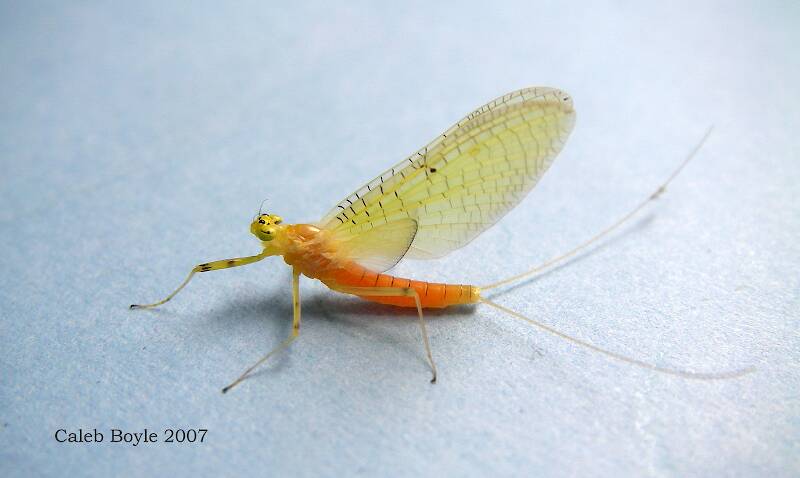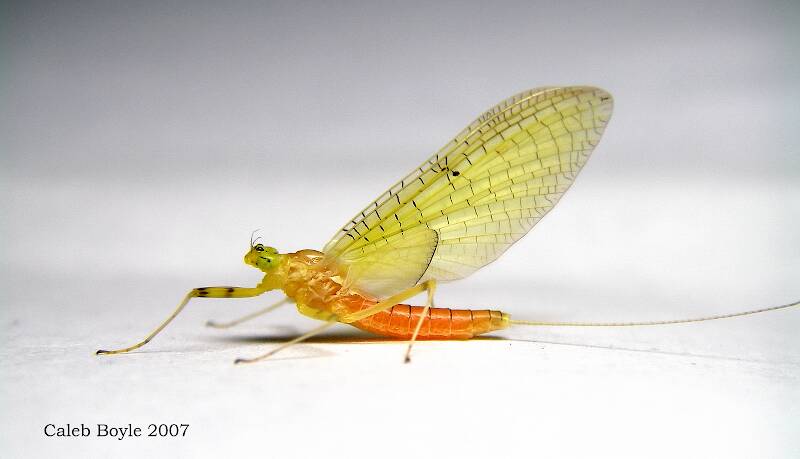
Salmonflies
Pteronarcys californica
The giant Salmonflies of the Western mountains are legendary for their proclivity to elicit consistent dry-fly action and ferocious strikes.
Featured on the forum

This is a striking caddis larva with an interesting color pattern on the head. Here are some characteristics I was able to see under the microscope, but could not easily expose for a picture:
- The prosternal horn is present.
- The mandible is clearly toothed, not formed into a uniform scraper blade.
- The seems to be only 2 major setae on the ventral edge of the hind femur.
- Chloride epithelia seem to be absent from the dorsal side of any abdominal segments.
Based on these characteristics and the ones more easily visible from the pictures, this seems to be Grammotaulius. The key's description of the case is spot-on: "Case cylindrical, made of longitudinally arranged sedge or similar leaves," as is the description of the markings on the head, "Dorsum of head light brownish yellow with numerous discrete, small, dark spots." The spot pattern on the head is a very good match to figure 19.312 of Merritt R.W., Cummins, K.W., and Berg, M.B. (2019). The species ID is based on Grammotaulius betteni being the only species of this genus known in Washington state.
- The prosternal horn is present.
- The mandible is clearly toothed, not formed into a uniform scraper blade.
- The seems to be only 2 major setae on the ventral edge of the hind femur.
- Chloride epithelia seem to be absent from the dorsal side of any abdominal segments.
Based on these characteristics and the ones more easily visible from the pictures, this seems to be Grammotaulius. The key's description of the case is spot-on: "Case cylindrical, made of longitudinally arranged sedge or similar leaves," as is the description of the markings on the head, "Dorsum of head light brownish yellow with numerous discrete, small, dark spots." The spot pattern on the head is a very good match to figure 19.312 of Merritt R.W., Cummins, K.W., and Berg, M.B. (2019). The species ID is based on Grammotaulius betteni being the only species of this genus known in Washington state.

Troutnut is a project started in 2003 by salmonid ecologist Jason "Troutnut" Neuswanger to help anglers and
fly tyers unabashedly embrace the entomological side of the sport. Learn more about Troutnut or
support the project for an enhanced experience here.
CalebBoyle has attached these 2 pictures to aid in identification. The message is below.


CalebBoyle on Mar 30, 2007March 30th, 2007, 2:53 pm EDT
Hello all,
This is my first time posting and I must agree with everyoen, this is the best aquatic entomology site by far for the flyfisherman. I have a mayfly hatch from my aquarium that is quite unique in its coloration. I'm pretty sure its a maccaffertium species, but I'm not sure which one. Anyone have some ideas?
This is my first time posting and I must agree with everyoen, this is the best aquatic entomology site by far for the flyfisherman. I have a mayfly hatch from my aquarium that is quite unique in its coloration. I'm pretty sure its a maccaffertium species, but I'm not sure which one. Anyone have some ideas?
Konchu on Mar 30, 2007March 30th, 2007, 3:01 pm EDT
or Stenacron??? I just moved and all my notes/books are tucked away in boxes, but that is my initial guess based on your photos. Nice pictures, by the way.
CalebBoyle on Mar 30, 2007March 30th, 2007, 3:07 pm EDT
It Could be. Is there a good key to look for in the s to seperate the stenacron and Macc? The only thing I can find in my book by Cormier and Knopp, is the shape of the gills.
Konchu on Mar 30, 2007March 30th, 2007, 3:12 pm EDT
Stenacron has the pointy gills
Stenonema & M. don't
That's what I use for starters
Stenonema & M. don't
That's what I use for starters
Troutnut on Mar 30, 2007March 30th, 2007, 3:16 pm EDT
I think that prominent black spot on the wing means it's Stenacron.
I have no clue how to tell one Stenacron species from another, but the one most commonly referenced is Stenacron interpunctatum, so that's as good a guess as any.
I have no clue how to tell one Stenacron species from another, but the one most commonly referenced is Stenacron interpunctatum, so that's as good a guess as any.
Jason Neuswanger, Ph.D.
Troutnut and salmonid ecologist
Troutnut and salmonid ecologist
CalebBoyle on Mar 30, 2007March 30th, 2007, 3:18 pm EDT
Cool, I didn't know about the black dot thing. It looks alot like your stenacron species Jason, except mine is a little more pink in the abdomen.
Konchu on Mar 31, 2007March 31st, 2007, 1:44 am EDT
The pink is probably the eggs.
GONZO on Mar 31, 2007March 31st, 2007, 6:53 am EDT
CalebBoyle-
Beautiful female dun--nice photos. The dark area in the third space on the wing (between R1 and R2) is usually a good character for distinguishing between Stenacron and Maccaffertium or Stenonema adults. It is expressed either as a black dot, as in your specimen, or, more commonly, as a dark patch that connects or nearly connects two or three crossveins.
Distinguishing the Stenacron species as adults is pretty tough and usually requires a male specimen (for penes differentiation) or rearing adults from identified larvae. This specimen lacks the dark spiracular marks (spiracles are the little breathing holes along the abdomen) and the dark streak below the wing base that one often sees on Stenacron interpunctatum. But, as far as I know, these may not be definitive characters.
Beautiful female dun--nice photos. The dark area in the third space on the wing (between R1 and R2) is usually a good character for distinguishing between Stenacron and Maccaffertium or Stenonema adults. It is expressed either as a black dot, as in your specimen, or, more commonly, as a dark patch that connects or nearly connects two or three crossveins.
Distinguishing the Stenacron species as adults is pretty tough and usually requires a male specimen (for penes differentiation) or rearing adults from identified larvae. This specimen lacks the dark spiracular marks (spiracles are the little breathing holes along the abdomen) and the dark streak below the wing base that one often sees on Stenacron interpunctatum. But, as far as I know, these may not be definitive characters.
Quick Reply
Related Discussions
Topic
Replies
Last Reply
0
Oct 19, 2006
by GONZO
by GONZO
Re: Cahills hatching characteristics and swimming ability
In Stenacron interpunctatum Mayfly Nymph by Chadwick
In Stenacron interpunctatum Mayfly Nymph by Chadwick
1
Jul 2, 2009
by GONZO
by GONZO
3
Sep 4, 2012
by Entoman
by Entoman
8
Jun 5, 2007
by Dinerobyn
by Dinerobyn



